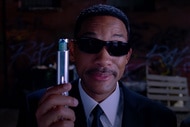The tragic truth about X-Men mutations

Stan Lee and Jack Kirby created the X-Men in 1963, in the midst of the civil rights movement, as a way of using genre to talk about the value of our differences. Nearly 40 years later, those characters came to life on the big screen when the first X-Men movie was released in 2000, 20 years ago this month.
While the story might have served as an allegory over the years for various civil rights movements, it does so by way of drastic genetic variation.
The so-called mutant gene interacts with select individuals uniquely. No two persons are affected in the same way. The result is a growing population of people, each with a distinct genetic expression on a macro-scale.
The comics and movies don’t generally concern themselves with the science of it all, taking it at face value that such a diverse slate of mutations is possible. But, what would happen if the human genome decided, all at once, to shuffle the deck on each of us?
WHAT COULD CAUSE SUCH DRASTIC MUTATION?
Mutation, as it’s depicted on the screen and within the pages of comic books, involves a mass-scale change of the human genome. Changes in DNA, across a species, have and still happen. But usually, it happens within sub-groups of a species who are impacted by an external change.
Another term for evolution, after all, is natural selection. Natural pressures act on a species, selecting for certain individuals who then pass their genetic information onto their offspring. Which is to say, those natural pressures don’t exactly cause mutation, but they do reinforce it.
Most mutations happen without any external cause, they happen as a result of an error in the copying process. DNA copies itself over and over again and sometimes it doesn’t copy just right. Kind of how when you copy a sheet of paper on an office copier, it loses some of its fidelity. Over time, if you continue to make copies of copies of copies, you’ll end up with something entirely different than what you began with.
Now imagine that differences in light exposure or toner levels resulted in different errors in the copying of your document. Some of those errors would make the document unreadable and you throw those away. You keep the copies that work and continue to copy them. That’s how natural selection enforces but doesn’t cause change over time.
Mutations can also occur as a result of external forces, like exposure to chemicals or radiation. All of us are exposed to radiation all the time. The Sun bombards us with radiation, the food we eat is radioactive, even we are radioactive.
The radiation or chemical exposure you encounter in your day-to-day life isn’t generally lethal, but it can cause errors in the copying of your DNA, which may result in minor changes, some of them good, some of them bad. Those changes, over time, result in larger changes within a population, as the environment selects for beneficial changes.
In truth, mutations on the scale that we see in X-Men stories couldn’t result from natural mutation and would, necessarily, require a push from external sources.
Research undertaken after nuclear accidents, like the one that happened in Fukushima, Japan, have shown that exposure to high levels of ionized radiation (the type of radiation that can alter DNA) is capable of altering DNA not just in living organisms, but in their offspring.
These mutations, however, are often fatal and, even when they’re not, don’t result in the sorts of high-level mutations we see in X-Men characters.
Let’s suppose, though, that some external factor was capable of impacting global populations and changed the genome in such a way that complex mutations resulted in individuals. What would happen then?
THE REALITY OF THE MUTANT GENE
It’s likely that many of us have considered what it might be like to live in the world of the X-Men. Would you want to be an old-world human, or a member of the new species, a target of persecution but equipped with incredible powers?
In the real world, we’re all mutants, so to speak. Mutations happen all the time, driving evolution through its slow processes. Each of us carries, on average, roughly 100 to 200 mutations in our DNA, though most of these have no apparent impact on our bodies. But we’re talking about large-scale mutations, the sort that gives you wings, or advanced healing ability.
What it means for two organisms to be a separate species has changed in the years since Darwin first laid down the groundwork for the theory of evolution. Even today, it’s a moving target we’re not quite capable of putting our finger on.
Some biologists draw the line at niches, delineating species by where they live and what they do, while others use physical characteristics to separate one species from another. Some scientists believe the ability to mate and produce viable, fertile offspring is the relevant criterion. The only thing we really know for sure is that the separation of species is more a spectrum than anything else. Since mutation is constant, the separation of one group from another is always changing.
Still, it’s clear there is some separation of species, even if we’re unsure where to draw the line. For our purposes, we’ll use the ability to interbreed and create fertile offspring as our dividing line.
In X-Men stories, mutants regularly interbreed with humans, suggesting that despite the drastic changes in their DNA, they remain similar enough for procreation.
There is some evidence to support this sort of activity.
Research involving crows of two distinct species has found that they are able to interbreed, though they generally prefer not to. This is despite the fact that the two groups appear physically distinct.
Researchers have found that the physical differences are a result of only 82 genetic differences, out of 1.2 billion. Those mutations have impacted the physical appearance of the animals without impacting their ability to reproduce together.
Given what we see canonically inside Marvel’s stories, a similar process is suggested. The drastic physical changes which allow for control of the weather, or the ability to teleport, do not impact the ability of individuals to bear children.
By one definition, at least, this means that humans and mutants remain a singular species, despite all evidence to the contrary.
Surely, some mutants would retain genome similar to allow for this, but not all. The genetic variations needed to create the incredible array of changes witnessed in X-Men stories would render many mutants too genetically different by far to stand any chance of interbreeding not only with humans but with anyone else.
As the mutation spreads, we would end up with a global population of genetic islands, incapable of breeding with anyone, or else capable of breeding only with a select group of those who share mutations similar enough.
The end result is one of two possibilities. The first is that humanity, within a few generations, will die out entirely, the victims of a sort of genetic Tower of Babel, rendering everyone’s genomes incapable of communicating or interacting with one another. The second is a massive splintering of the population into a series of sub-groups, each of them defined by their specific type of mutation.
Considering that mutations seem to be random and those with similar mutations are spread all over the globe, the second possibility is unlikely. Though, continued globalization might allow for intentional enclaves of similar individuals to find one another.
The sad truth is, the world as it’s presented within the pages of the X-Men, wherein these mutations result in drastic physical changes without impacting procreation, just isn’t likely. But, who knows, maybe our understanding of species differentiation is even more incomplete than we know, and we’re all just one flip of a switch away from incredible powers and a societal reckoning with our understanding of our differences and similarities.
Fingers crossed.


























